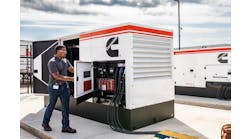How Battery Energy Storage Changes the Game
Schneider Electric’s Andy Haun offers insight on how battery energy storage has the potential to change the energy landscape.
We are in the midst of a massive shift in how energy is both produced and consumed. Power generation today is becoming more decentralized and distributed, produced at the edges of the grid, behind-the-meter (BTM) of commercial and industrial businesses, and on the rooftops of Prosumers’ homes. These Distributed Energy Resources (DERs) have the ability to contribute greatly to a decarbonized energy landscape, but it is energy storage, specifically affordable battery storage, that will fully unlock this potential.
The battery’s time has come
There are several different types of energy storage, but battery energy storage (BESS) is quickly becoming the solution of choice for several reasons. Battery energy storage solutions are flexible – they can be deployed by electric utilities, a private microgrid, or in residential solar installations. Lithium ion (Li-ion) batteries are scalable and can be located anywhere they are needed to create a storage bank to support nearly any type of energy generation or distribution scenario.
The biggest catalyst for the uptick in BESS adoption is the extreme drop in price that batteries have achieved in the past 10 years. Driven by the increase in electric vehicles, manufacturers are investing heavily in battery technology and production, creating more affordable batteries to meet demand. Bloomberg New Energy Finance expects the cost of Li-ion batteries to decline to as little as $73/kWh by 2030.
Coincidently, rechargeable zinc-hybrid batteries are gaining traction in the market due to the lower material cost and wider availability of zinc versus the scarcer minerals needed for Li-ion batteries. Recent advancements put zinc battery costs at around $100/kWh – a potential game changer for the renewable energy market.
BESS is becoming a critical asset for firming and smoothing of intermittent renewable generation, so much so, that BNEF expects wind and solar will generate 50 percent of the world’s power generation by 2050 thanks in large part to decreasing battery costs.
Money saving use cases for BESS
Affordable battery storage makes possible a range of use cases that enable new and expanded energy production and consumption models for end users. The BESS enables DERs to meet demand even when the sun isn’t shining and the wind isn’t blowing while helping end users save money, provide resilience and even generate revenue. Among – many potential use cases for BESS, the most common are peak shaving and renewable self-consumption.
Peak shaving: Peak shaving involves reducing the peak power consumed from the grid during times when it is most expensive to consume that power, i.e., during utilities’ on-peak rate periods or when it contributes to users demand charges. There are several methods to reduce peak consumption.
For example, most commercial and industrial (C&I) customers pay demand charges as part of their energy bill. Demand charges are a relatedto the peak power capacity that utilities are required to reserve to meet peak demand needs. These reserves and subsequent demand charges are costly and and can represent as much as 50-70 percent of the energy bill. By reducing peak demand, customers could save 10-20 percent on their energy charges.
Another peak shaving method is linked to time-of-use (TOU) energy management. Essentially, this refers to acquiring energy at times when it is less expensive to produce. By reducing electricity consumption during peak rate hours, customers can lower their energy costs. BESS allows customers to charge their batteries during off-peak rate hours and discharge stored energy during the mid/high-peak rate hours, thereby minimizing high price – energy use and reducing costs.
Battery energy storage has the potential to change the energy landscape by enabling a number of energy efficient use cases and boosting widespread adoption of DERs.
Renewable self consumption: When onsite renewable energy production exceeds load demand, a BESS allows users to store the excess energy produced. This stored energy can be used in the future to compensate for periods of insufficient renewable output, maximizing the financial benefit of the renewable assets. Additionally, by charging the BESS directly from a solar PV renewable resource, end users can take advantage of the federal Solar Incentive Tax Credit (ITC) and apply it to the capital costs of the BESS, saving end users’ money in multiple ways.
For Prosumers, peak shaving and renewable self-consumption allows storage of energy, both as “free” energy generated by renewable sources and grid energy acquired during times when it is least expensive such as during off-peak rate periods. They can then use the less expensive stored energy to offset costs during on-peak energy hours.
For data centers, critical infrastructure and industrial applications, BESS can provide similar benefits, just on a larger scale. For example, facilities that require high quality uninterrupted power often operate an uninterrupted power supply (UPS), which includes battery energy storage to enable continuous operation for critical assets during grid outages. When paired with energy control software, these critical power facilities can monitor and control their energy resources to optimize performance and leverage the UPS to act as a sophisticated energy storage solution. If additional power is required by the UPS load, it is drawn from low cost stored energy in the UPS battery, rather than elevated peak demand on the grid.
Microgrid resilience: The most compelling use case for battery energy storage is resilience. As we’ve seen recently with extreme weather incidents impacting grid energy for days and even weeks, there is a growing need for back-up energy sources. Acting as the microgrid anchor resource, a BESS not only provides excellent energy flexibility for peak shaving, but also provides a resilient energy source to ride through power outages.
Battery energy storage has the potential to change the energy landscape by enabling a number of energy efficient use cases and boosting widespread adoption of DERs. Thanks to a precipitous reduction in cost, battery storage is much more economically viable today, offering end users additional cost-saving flexibility along with sustainable energy choices for facilities and Prosumers alike.
Andy Haun is senior vice president and chief technology officer, microgrids, at Schneider Electric.







